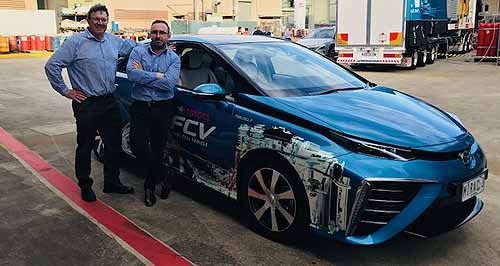News - General NewsCSIRO makes hydrogen breakthroughIt’s a gas: The CSIRO’s Matt Langley and David Viano with the hydrogen membrane. New CSIRO membrane set to transform hydrogen transport via liquid ammonia8 Aug 2018 AUSTRALIA’S government-backed CSIRO scientific research agency has developed a new membrane that can separate hydrogen from ammonia, paving the way for bulk hydrogen to be transported in the form of liquid ammonia using existing fuel transport infrastructure.
The breakthrough has major implications for hydrogen fuel-cell motor vehicles, as it means the fuel can be shifted from the point of manufacture to refuelling stations more easily than gaseous hydrogen which needs to be stored under high pressure, not only making it potentially hazardous but also requiring costly new transport infrastructure.
Under the CSIRO’s new system, the ammonia is passed through the membrane in a module at a refuelling station, separating ultra-high-purity hydrogen gas ready for pumping into vehicles.
The CSIRO technology was demonstrated today at the Queensland Centre for Advanced Technologies where two fuel-cell cars, a Toyota Mirai and a Hyundai Nexo, were refuelled with hydrogen made from ammonia.
The process has been welcomed by hydrogen vehicle lobby group, Hydrogen Mobility Australia (HMA). Three of the group’s 13 members – gas manufacturer BOC and vehicle distributors Toyota Australia and Hyundai Motor Company Australia – are supporting the CSIRO development with the hope that it will lay the foundation for the introduction of fuel-cell electric vehicles (FCEVs) in Australia.
The CSIRO plans to scale up the membrane process for several larger demonstrations in Australia and abroad.
The development of the membrane is part of a broader focus by the CSIRO on the hydrogen technology chain.
This includes development of technologies to improve the generation of both hydrogen and ammonia from solar energy using water electrolysis and ammonia synthesis and even using ammonia directly to generate energy via both combustion and fuel cells.
The CSIRO says recent advances in solar and electrochemical technologies mean renewable hydrogen production is expected to become competitive with fossil fuel production.
CSIRO chief executive Larry Marshall described the demonstration of the membrane capability as a watershed moment for energy.
“We look forward to applying CSIRO innovation to enable this exciting renewably-sourced fuel and energy storage medium a smoother path to market,” he said.
According to HMA, local and state governments have committed to building hydrogen refuelling stations in Australia in the next 12 to 18 months.
Hyundai has become the first motor company to commit to importing FCEV cars, with small numbers of Nexo SUVs due to arrive in Australia late this year.
The Australian Capital Territory government has ordered 20 Nexos as part of its Hornsdale Wind Farm project from early next year.
Toyota has been championing FCEV technology in Australia by demonstrating a Mirai at various events. The company developed its own mobile refuelling station to support the program.
HMA CEO Claire Johnson said the CSIRO technology had the potential to create new export markets for Australia while also opening local opportunities for hydrogen mobility.
“With Australia a potential supplier of hydrogen to the world, it is imperative of governments at all levels to work with industry to realise the full potential of this opportunity, including the development of a local hydrogen-powered transport sector,” she said.  Read more |
Click to shareGeneral News articlesResearch General News Motor industry news |

















Facebook Twitter Instagram